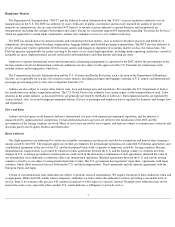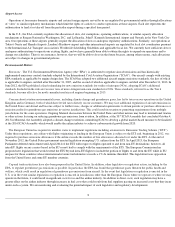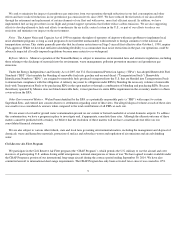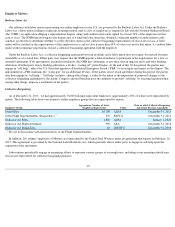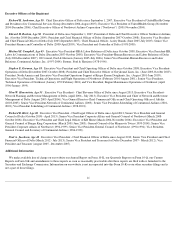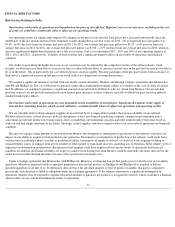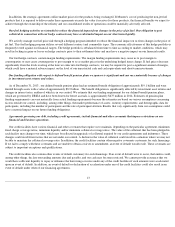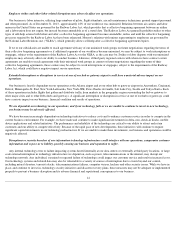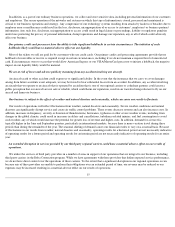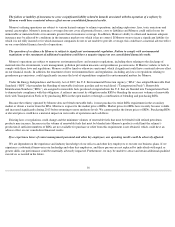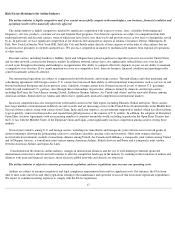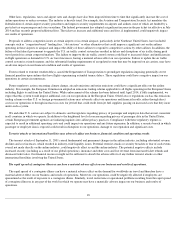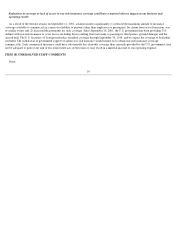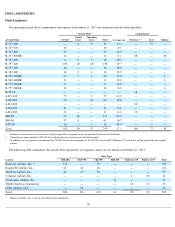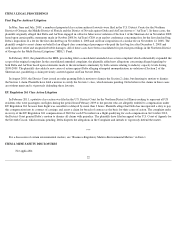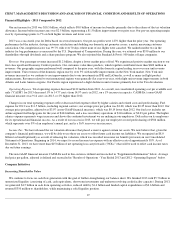Delta Airlines 2013 Annual Report Download - page 23
Download and view the complete annual report
Please find page 23 of the 2013 Delta Airlines annual report below. You can navigate through the pages in the report by either clicking on the pages listed below, or by using the keyword search tool below to find specific information within the annual report.
Risk Factors Relating to the Airline Industry
The airline industry is highly competitive and, if we cannot successfully compete in the marketplace, our business, financial condition and
operating results will be materially adversely affected.
The airline industry is highly competitive, marked by significant competition with respect to routes, fares, schedules (both timing and
frequency), services, products, customer service and frequent flyer programs. Our domestic operations are subject to competition from both
traditional network and discount carriers, some of which may have lower costs than we do and provide service at low fares to destinations served
by us. In particular, we face significant competition at our domestic hub and gateway airports in Atlanta, Cincinnati, Detroit, Minneapolis-St.
Paul, New York-LaGuardia, New York-JFK, Salt Lake City and Seattle either directly at those airports or at the hubs of other airlines that are
located in close proximity to our hubs and gateways. We also face competition in smaller to medium-sized markets from regional jet operations
of other carriers.
Discount carriers, including Southwest, JetBlue, Spirit and Allegiant have placed significant competitive pressure on us in the United States
and on other network carriers in the domestic market. In addition, network carriers have also significantly reduced their costs over the last
several years through restructuring and bankruptcy reorganization. Our ability to compete effectively depends, in part, on our ability to maintain
a competitive cost structure. If we cannot maintain our costs at a competitive level, then our business, financial condition and operating results
could be materially adversely affected.
Our international operations are subject to competition from both domestic and foreign carriers. Through alliance and other marketing and
codesharing agreements with foreign carriers, U.S. carriers have increased their ability to sell international transportation, such as services to and
beyond traditional European and Asian gateway cities. Similarly, foreign carriers have obtained increased access to interior U.S. passenger
traffic beyond traditional U.S. gateway cities through these relationships. In particular, alliances formed by domestic and foreign carriers,
including SkyTeam, the Star Alliance (among United, Lufthansa German Airlines, Air Canada and others) and the oneworld alliance (among
American Airlines, British Airways, Qantas and others) have significantly increased competition in international markets.
Increased competition has also emerged from well-funded carriers in the Gulf region, including Emirates, Etihad and Qatar. These carriers
have large numbers of international widebody aircraft on order and are increasing service to the United States from their hubs in the Middle East.
Several of these carriers, along with carriers from China, India and Latin America, are government supported or funded, which has allowed them
to grow quickly, reinvest in their product and expand their global presence at the expense of U.S. airlines. In addition, the adoption of liberalized
Open Skies Aviation Agreements with an increasing number of countries around the world, including in particular the Open Skies Treaties that
the U.S. has with the Member States of the European Union and Japan, could significantly increase competition among carriers serving those
markets.
Several joint ventures among U.S. and foreign carriers, including our transatlantic and transpacific joint ventures, have received grants of
antitrust immunity allowing the participating carriers to coordinate schedules, pricing, sales and inventory. Other joint ventures that have
received anti-trust immunity include a transatlantic alliance among United, Air Canada and Lufthansa, a transpacific joint venture among United
and All Nippon Airways, a transatlantic joint venture among American Airlines, British Airways and Iberia and a transpacific joint venture
between American Airlines and Japan Air Lines.
Consolidation in the domestic airline industry, changes in international alliances and the rise of well-funded government sponsored
international carriers have altered and will continue to alter the competitive landscape in the industry by resulting in the formation of airlines and
alliances with increased financial resources, more extensive global networks and altered cost structures.
The airline industry is subject to extensive government regulation, and new regulations may increase our operating costs.
Airlines are subject to extensive regulatory and legal compliance requirements that result in significant costs. For instance, the FAA from
time to time issues directives and other regulations relating to the maintenance and operation of aircraft that necessitate significant expenditures.
We expect to continue incurring expenses to comply with the FAA's regulations.
17


